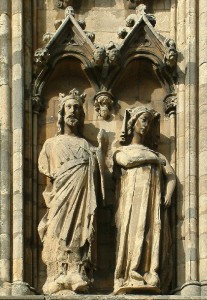In lineage societies, the frequently-used term ‘gateway ancestor’ refers to an ancestor who has a known lineage which can be traced back to a person of prominence. Proven lines to gateway ancestors can result in descendants being accepted into many hereditary societies. In the following piece, I will be using my own ancestor, Robert Abell, as an example. Born about 1605 in Stapenhill, Derbyshire, Abell came to Massachusetts in 1630.[1] Through Robert Abell, I was able to trace my ancestry back to individuals such as Eystein Glumra (born c. 805), Amadeus of Oscheret (born c. 790), and Fulcois, Count of Perche, a tenth-century French nobleman.
I began my research by first confirming my connection to Robert Abell through my great-great-grandmother, Jennie Luther, daughter of Edwin Sanford and Jennie H. (Connolly) Luther. Using works including The Luther Family in America and The Luther Genealogy, as well as vital records, probate records, and other widely available resources, I was able to confirm the following ancestry of Jennie Luther:[2]
- Robert Abell married Joanna _____
- Mary Abell married Samuel Luther
- Mehitable Luther married Ebenezer Cole
- Mary Cole married William Salisbury
- Sarah Salisbury married Calvin Luther
- Caleb Luther married Lovinia Seamans
- Joseph Parsons Luther married Harriet B. Westcott
- Charles Henry Luther married Ellen Hughes Tompkins
- Edwin Sanford Luther married Jennie H. Connolly
- Jennie Luther married Alfred Garceau
When attempting to learn more about my gateway ancestor Robert Abell, I came across the book The Abell Family in America, which included a lengthy account of his ancestry.[3] I then turned to Gary Boyd Roberts’s Royal Descents of 600 Immigrants, which showed that Robert Abell was a descendant of King Edward I of England and his wife, Eleanor of Castile, through their daughter Joan of Acre.[4] Other sources which are indispensable in the study of royal ancestry are the works of Douglas Richardson, including Royal Ancestry: A Study in Colonial and Medieval Families and Plantagenet Ancestry: A Study in Colonial and Medieval Families.[5] The latter source also suggested that Robert Abell was a descendant of King Henry II of England and his mistress Ida through their son, William Longespee, and King John and his mistress, surnamed de Warenne, through their son, Richard Fitzroy.[6]
Another resource which is extremely useful in establishing royal ancestry are the heraldic visitations of England, which often provide lineages of individuals from the time of the Visitation (usually in the sixteenth and/or seventeenth centuries) as far back as could be traced at that time. In the Visitation of Shropshire, 1623, I was able to find a lengthy ancestry of Sir Arthur Mainwaring, who married his kinswoman Margaret Mainwaring. This ancestry was traced all the way back to Hamelin of Anjou, half-brother of King Henry II.[7]
While these sources are useful for tracing your ancestry to kings and queens, they are also beneficial in showing connections to earls, barons, and knights, which in turn can lead to uncovering further ancestral roots. Once royal connections have been established, other works such as Frederick Lewis Weis’s Ancestral Roots of Certain American Colonists who Came to America Before 1700 can be used to continue your research. In this work, I was able to determine that King Henry II was descended (24 generations removed) from Cedric, King of the West Saxons from 519 to 534.[8] Therefore, through my great-great-grandmother, I am a descendant of Cedric, King of the West Saxons, as well as his descendant, King Henry II of England.
All of the sources mentioned in this article are considered valid in establishing royal connections. Many of these works contain extensive footnotes which can be used to locate the source of the information provided.
Other works which are useful include:
- Frederick Lewis Weis, The Magna Charta Sureties, 1215
- Douglas Richardson, Magna Carta Ancestry
- Gateway Ancestors of the Magna Charta Sureties, http://www.magnacharta.com/bomc/bomc-gateway-ancestors/
- Gateway Ancestors to the Descendants of Charlemagne, http://www.charlemagne.org/Gateway.html
Notes
[1] Carl Boyer, Medieval English Ancestors of Robert¹ Abell: Who Died in Rehoboth, Plymouth Colony, 20 June 1663: with English Ancestral Lines of Other Colonial Americans (Santa Clarita, Calif., 2001).
[2] Leslie Luther, The Luther Family in America (Moravia, N.Y.: Chronicle-Guidance Publications, 1976), and Leslie L. Luther, The Luther Genealogy (Rockport, Me.: Penobscot Press, 2001).
[3] Boyer, Medieval English Ancestors of Robert¹ Abell.
[4] Gary Boyd Roberts, Royal Descents of 600 Immigrants (Baltimore: Genealogical Publishing Co., 2008), p. 312.
[5] Douglas Richardson, Royal Ancestry: A Study in Colonial and Medieval Families (Salt Lake City, 2013), and Douglas Richardson, Plantagenet Ancestry: A Study in Colonial and Medieval Families (Salt Lake City, 2011).
[6] Richardson, Plantagenet Ancestry, pp. 33, 92.
[7] Robert Treswell, The Visitation of Shropshire, 1623 (London, 1889), pp. 347-49.
[8] Frederick Lewis Weis, Ancestral Roots of Certain American Colonists who Came to America Before 1700 (Baltimore: Genealogical Publishing Co., 1992), pp. 1-3.
Share this:
About Zachary Garceau
Zachary J. Garceau is a former researcher at the New England Historic Genealogical Society. He joined the research staff after receiving a Master's degree in Historical Studies with a concentration in Public History from the University of Maryland-Baltimore County and a B.A. in history from the University of Rhode Island. He was a member of the Research Services team from 2014 to 2018, and now works as a technical writer. Zachary also works as a freelance writer, specializing in Rhode Island history, sports history, and French Canadian genealogy.View all posts by Zachary Garceau →
